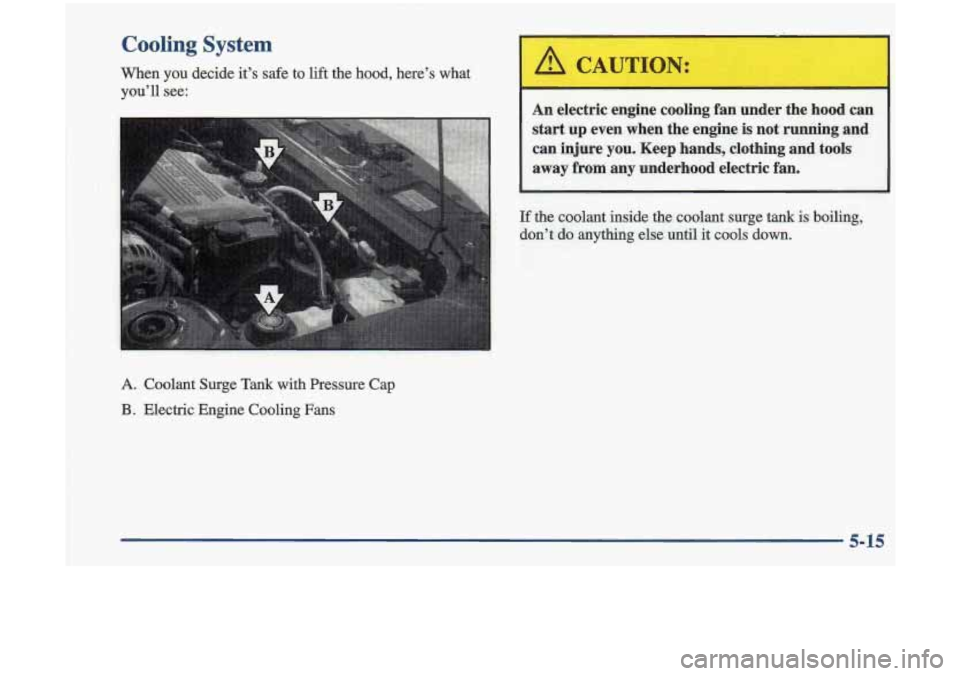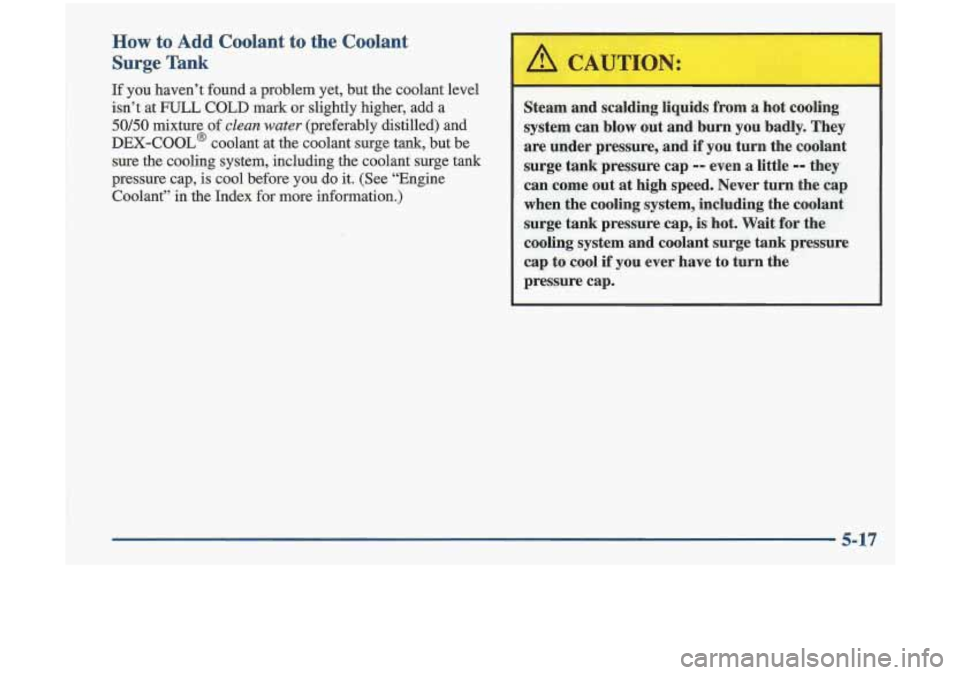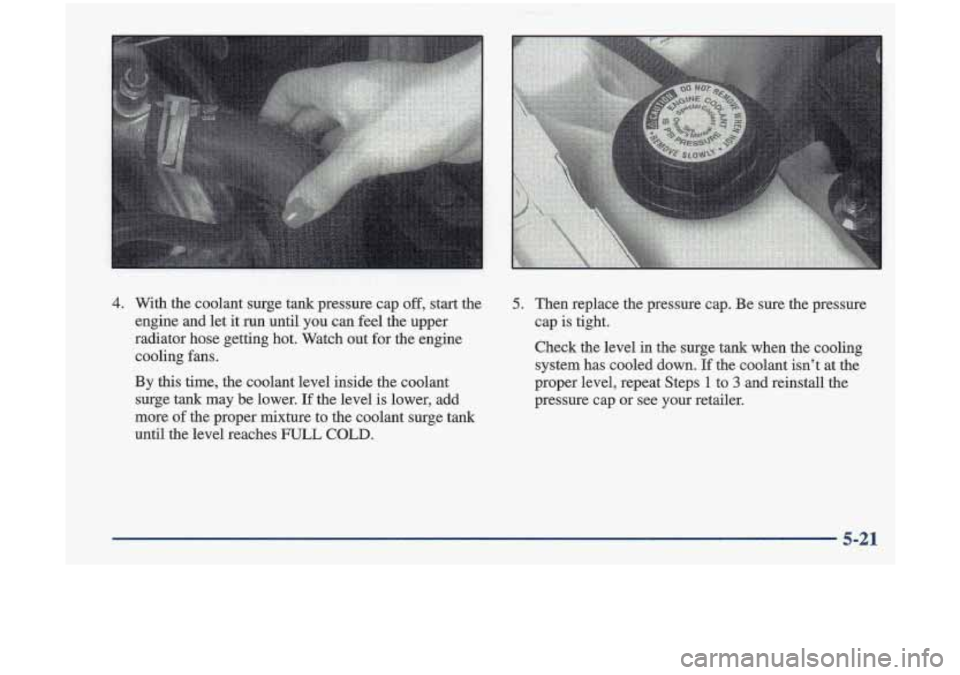Oldsmobile Cutlass 1998 Owner's Manuals
Cutlass 1998
Oldsmobile
Oldsmobile
https://www.carmanualsonline.info/img/31/9579/w960_9579-0.png
Oldsmobile Cutlass 1998 Owner's Manuals
Trending: instrument cluster, fuel filter, warning, radio controls, steering wheel, set clock, coolant
Page 201 of 348
Cooling System
When you decide it’s safe to lift the hood, here’s what
you’ll see:
A Coolant Surge Tank with Pressure Cap
B. Electric Engine Cooling Fans
1
Ik I
/!II CAUTION:
An electric engine cooling fan under the hood can
start up even when the engine is not runnimg
and
can injure you. Keep hands, clothing and tools
away from any underhood electric fan.
If the coolant inside the coolant surge tank is boiling,
don’t
do anytlung else until it cools down.
Page 202 of 348
The coalant level should be at or above FULL COLD
m-ark .or slightly higher.
If it isn’t, you may have a leak in the radiator hoses,
heater hoses, radiator, water
pump or somewhere else in
the cooling system.
Heater and radiator hoses, and other engine
parts, can be very hot. Don’t touch them.
If you
do, you can be burned.
Don’t run the engine
if there is a leak. If you run
the engine, it could lose all coolant. That could
cause
an engine fire, and you could be burned.
Get any leak fixed before you drive the vehicle.
1 NOTICE:
Engine damage from running your engine
without coolant isn’t covered by your warranty.
If there seems to be no leak, with the engine on, check to
see if the electric engine cooling fans are running.
If the
engine is overheating, both fans should be running.
If
they aren’t, your vehicle needs service.
Page 203 of 348
How to Add Coolant to the Coolant
Surge Tank
If you haven’t found a problem yet, but the coolant level
isn’t at
FULL COLD mark or slightly higher, add a
50/50 mixture of clean water (preferably distilled) and
DEX-COOL’ coolant at the coolant surge tank, but be
sure the cooling system, including the coolant surge tank
pressure cap,
is cool before you do it. (See “Engine
Coolant’’ in the Index for more infomation.)
I
Steam and scaldmg liquids from a hot cooling
system can blow out and burn you badly. They
are under pressure, and
if you turn the coolant
surge tank pressure cap
-- even a little -- they
can come out at high speed. Never
turn the cap
when the cooling system, including the coolant
surge tank pressure cap, is hot. Wait for the
cooling system and coolant surge
tank pressure
cap to cool
if you ever have to turn the
pressure cap.
5-17
Page 204 of 348
Page 205 of 348
I NOTICE:
In cold weather, water can freeze and crack the
engine, radiator, heater core and other parts.
So
use the recommended coolant.
You can be bmrned if you spill coolant on hot ,
engine parts. Coolant contains ethylene glycol
and it will burn if the engine parts are hot
enough. Don’t spill coolant on
a hot engine.
1. You can remove the coolant mge tank pressure .cap
when the cooling system, inclu-ding the coalimt surge
tank pressare cap and upper radiatox hose, is no
longer hot. Tm the pressure cap slowly about
one-quafter
turn to the left and then stop.
If you hear a hiss, wait for that to stop. A hiss means
there is still some pressure left.
5-19
1
I
Page 206 of 348
Page 207 of 348
5. Then replace the pressure cap. Be sure the pressure
cap
is tight.
Check the level in the age tank when the cooling
system has cooled down. If the coolant isn't at the
proper level, repeat Steps
1 to 3 and reinstall the
pressure cap or see
your retailer.
5-21
Page 208 of 348
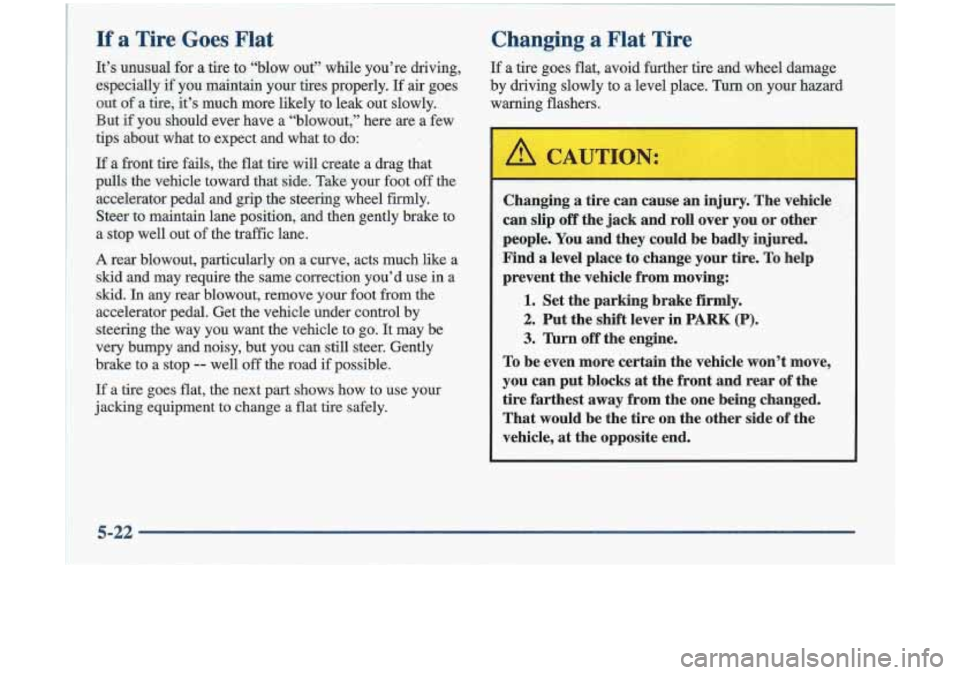
~~ ~. ~~ ~
If a Tire Goes Flat
It’s unusual
for a tire to “blow out” while you’re driving,
especially if you maintain your tires properly. If air goes
out
of a tire, it’s much more likely to leak out slowly.
But if you should ever have a “blowout,” here
are a few
tips about what to expect and what to do:
If a front tire fails, the flat tire will create a drag that\
pulls the vehicle toward that side. Take your foot off the
accelerator pedal and grip the steering wheel firmly.
Steer to maintain lane position, and then gently brake to
a stop well out of the traffic lane.
A rear blowout, particularly on a curve, acts much like a
skid and may require the same correction you’d use in a
skid.
In any rear blowout, remove your foot from the
accelerator pedal. Get the vehicle under control by
steering the way you want the vehicle to
go. It may be
very bumpy and noisy, but you can still steer. Gently
brake to a stop
-- well off the road if possible.
If a tire goes flat, the next part shows how to use your
jacking equipment to change a flat tire safely.
Changing a Flat Tire
If a tire goes flat, avoid further tire and wheel damage
by driving slowly to
a level place. Turn on your hazard
warning flashers.
:, , ,::*,,
Changing a tire can cause an injury. The vehicle
can slip off the jack and roll over you or other
people. You and they could be badly injured.
Find
a level place to change your tire. To help
prevent the vehicle from moving:
1. Set the parking brake firmly.
2. Put the shift lever in PARK (P).
3. ’krn off the .engine.
To be even more certain the vehicle won’t move,
you can put blocks
at the front and rear of the
tire farthest away from the one being changed.
That would be the’ tire on the other side of the
vehicle, at the opposite end.
5-22
Page 209 of 348
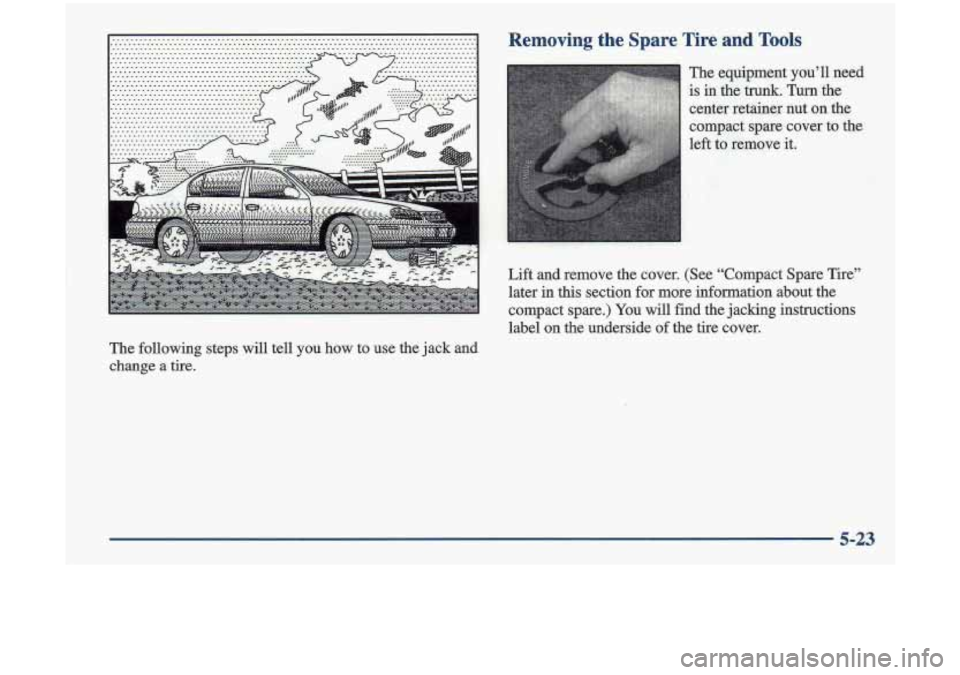
........................................................................\
....... ........................................................................\
........ ........................................................................\
....... ............................................. ..................... ............................................. ................. ............................................ .................. .......................................... .................. ........................................... .................... ............................................ ..-................ m
Removing the Spare Tire and Tools
The equipment you’ll need
is
in the trunk. Turn the
center retainer nut on the
compact spare cover to the
left to remove it.
Lift and remove the cover. (See “Compact Spare Tire”
later in this section for more information about the
compact spare.) You will find the jacking instructions
label on the underside of the tire cover.
The following steps will tell
you how to use the jack and
change
a tire.
5-23
Page 210 of 348
Turn the wing nut to the left
and remove it. Then lift off
the adapter ad remove tbe
spare tire.
Remove the jack and wheel wrench from the trunk.
Your vehicle’s jack and wheel wrench are stored in a
foam
tray.
Trending: relay, seats, battery location, fuses, washer fluid, manual transmission, hood open
